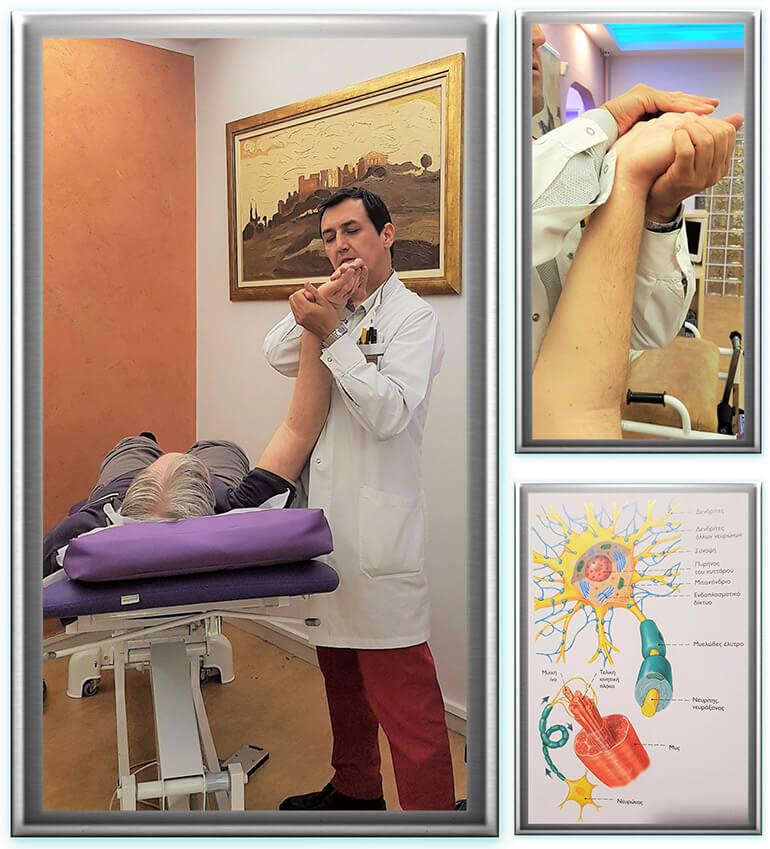Neurological Conditions
Personalized exercise and training programs for each patient: Experienced physiotherapists with deep knowledge of the subject.

- Vascular stroke (hemiplegia).
- Traumatic brain injury.
- Motor neurone disease.
- Parkinson's disease
- Alzheimer's disease
- Cerebral palsy.
- Brachial plexus injuries.
- Diseases/disorders of the peripheral nervous system.
What is it:
When blood flow to the brain is significantly reduced or interrupted, then we have a stroke.
The stroke can be ischemic, when a blood vessel clogs, or hemorrhagic, when the breaking of a blood vessel causes bleeding.
Clinical picture
Paralysis of one half of the body (upper and lower extremities of the same side). It can also affect the speech center leading to speech disorders.
Rehabilitation method
- PNF
- Bobath
- Biofeedback pillow for pelvic control.
- Treadmill
- Platform mounted parallel bars
- Proprioception and coordination exercises for the whole body.
- Balance disc
- Specialised RECK bike for upper and lower extremities training in neurological cases with active, passive, resistance and assisted movement options.
- Improving neuromuscular coordination.
- Autonomy
- Careful examination of the body (torso and upper and lower extremities) and the face.
- Reduction of spasticity.
- Development of a normal gait pattern.
- Respiratory control for improved energy, relaxation and self-control.
- Muscle function retraining
Development of the brain's control center through repetitive training (tomograph research has shown increased development in specific motor areas of the brain with training).
Early signs of Parkinson's disease or some other neurodegenerative disease are:
Not necessarily
- Balance problems
- Anxiety and depression
- Erectile and urinary dysfunction
- Hypotension
- Constipation
- Fatigue
- General movement slowing down is a very important sign.
«The specialized neurologist will make the diagnosis."
- Parkinson's disease can be treated with early diagnosis.
- Diet
- Medication
- Physiotherapy, kinesiotherapy.
- The active participation of every patient is a necessary condition for the best possible outcome of the disease.
What is it:
- In the mild form of the disease
- Short-term memory loss
- Difficulty in decision-making
- Irritability - Depression
- Lack of goals and general interest.
- Inability to identify faces, objects.
Rehabilitation method
- Proprioception and coordination exercises for the whole body.
- Specialised RECK bike for upper and lower extremities training in neurological cases with active, passive, resistance and assisted movement options.
- Improving neuromuscular coordination.
- Autonomy
- Careful examination of the body (torso and upper and lower extremities) and the face.
- Reduction of spasticity.
- Development of a normal gait pattern.
- Respiratory control for improved energy, relaxation and self-control.
- Muscle function retraining.
- Development of the brain's control center through repetitive training.
What is it:
Damage to the central nervous system that occurred during intrauterine life (toxoplasmosis, herpes, etc.) or during childbirth (brain anoxemia, perinatal asphyxia, etc.) or after childbirth (Meningitis, Encephalitis,)
Rehabilitation method
- Treadmill
- Proprioception and coordination exercises for the whole body.
- Balance disc
- Specialised RECK bike for upper and lower extremities training in neurological cases with active, passive, resistance and assisted movement options.
- Improving neuromuscular coordination.
- Autonomy
- Careful examination of the body (torso and upper and lower extremities) and the face.
- Reduction of spasticity.
- Development of a normal gait pattern.
- Respiratory control for improved energy, relaxation and self-control.
- Muscle function retraining.
- Development of the brain's control center through repetitive training.